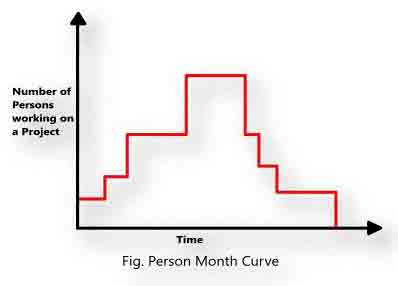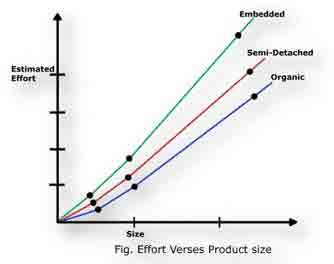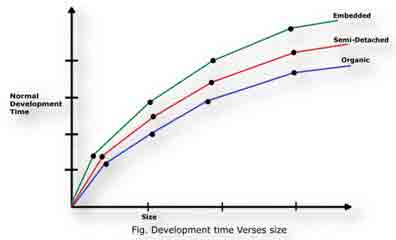Explain COCOMO model for project estimation
- COCOMO (Constructive Cost Estimation Model) was proposed by Boehm
- According to Boehm, software cost estimation should be done through three stages:
- Basic COCOMO,
- Intermediate COCOMO, and
- Complete COCOMO
Basic COCOMO Model
- The basic COCOMO model gives an approximate estimate of the project parameters
- The basic COCOMO estimation model is given by the following expressions
- Effort=a1+(KLOC)a2 PM | Tdev=b1*(Effort)b2 Months
- KLOC is the estimated size of the software product expressed in Kilo Lines of Code,
- a1, a2, b1, b2 are constants for each category of software products,
- Tdev is the estimated time to develop the software, expressed in months,
- Effort is the total effort required to develop the software product, expressed in person months (PMs).
| Project |
a1 |
a2 |
b1 |
b2 |
| Organic |
2.5 |
1.05 |
2.5 |
0.38 |
| Semidetached |
3.0 |
1.12 |
2.5 |
0.35 |
| Embedded |
3.6 |
1.20 |
2.5 |
0.32 |
- The effort estimation is expressed in units of person-months (PM)
- It is the area under the person-month plot (as shown in fig.)
- An effort of 100 PM
- does not imply that 100 persons should work for 1 month
- does not imply that 1 person should be employed for 100 months
- it denotes the area under the person-month curve (fig.)

(Figure: Person Month Curve)
- Every line of source text should be calculated as one LOC irrespective of the actual number of instructions on that line
- If a single instruction spans several lines (say n lines), it is considered to be nLOC
- The values of a1, a2, b1, b2 for different categories of products (i.e. organic, semidetached, and embedded) as given by Boehm
- He derived the expressions by examining historical data collected from a large number of actual projects
- Insight into the basic COCOMO model can be obtained by plotting the estimated characteristics for different software sizes
- Fig. shows a plot of estimated effort versus product size
- From fig. we can observe that the effort is somewhat superlinear in the size of the software product
- The effort required to develop a product increases very rapidly with project size

(Figure: Efforts vs Product Size)
- The development time versus the product size in KLOC is plotted in fig.
- From fig., it can be observed that the development time is a sublinear function of the size of the product
- i.e. when the size of the product increases by two times, the time to develop the product does not double but rises moderately
- From fig., it can be observed that the development time is roughly the same for all the three categories of products

(Figure: Development Time vs Size)
- Effort and the duration estimations obtained using the COCOMO model are called as nominal effort estimate and nominal duration estimate
- The term nominal implies that
- if anyone tries to complete the project in a time shorter than the estimated duration, then the cost will increase drastically
- But, if anyone completes the project over a longer period of time than the estimated, then there is almost no decrease in the estimated cost value